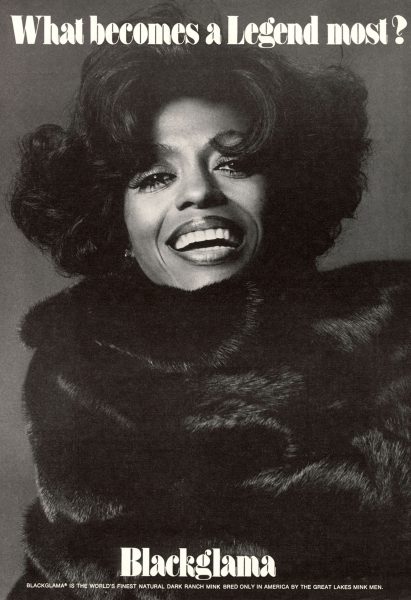Jonathan Faiers—
Fur Thinking
In 1963, as part of a publicity stunt, World Heavyweight Boxing Champion Sonny Liston had a pair of boxing gloves made from mink.

Heritage Auctions, HA.com
The gloves were used during press interviews between Liston and newcomer Muhammad Ali (then still known as Cassius Clay), the joke being that the soft touch of mink would spare Clay’s ‘pretty face’ during Liston’s punishment of him in the upcoming title fight. As it turned out Clay’s face was spared not by mink but his superior performance, with Liston giving up in the 7thround.
Sporting trivia aside, what the mink gloves remind us of, whether we are opposed to the wearing of fur or not, is its essentially tactile appeal. Nothing else feels like fur, a pleasure we can all recognise when stroking our favourite pet or, indeed, touching our own or loved one’s hair. Whilst infinitely more numerous than on the human head, the hairs making up an animal’s fur share many of the same properties as our own, keeping us warm, registering excitement or fear and of course a supreme sensuous experience. The closeness to our own hair reminds us of our original ‘furriness’ and our connection to animals both biological and symbolic.
It is this proximity and, most importantly, the promise of transformation that accounts for the appeal of fur and fur garments, a rich, complex and problematic history that is explored in detail in Fur: A Sensitive History.
But why write about fur, and why now? A simple answer would be that there is no book in print that tells the complex history of our relationship with fur. Fur’s increasingly controversial status has meant that reasoned discussion of its historical, economic and cultural importance is rare, and it is this lack of serious research that Fur: A Sensitive History hopes to address.
Wearer’s Rights

The Metropolitan Museum of Art, New York. Purchase, Mary Westmore Shively Bequest, in memory of her husband, Henry L. Shively, M.D.,1960
Fur has always been subject to criticism and restriction, from the historical sumptuary laws which decreed which sections of society were allowed to wear certain types of fur; generally finer and rarer furs were reserved for the upper classes – ermine’s use in regal and ceremonial dress being a reminder of this – while coarser shaggier furs were worn by the lower classes.
Today’s anti-fur movement may have eclipsed the economic and social divisions historical legislation against fur were anxious to maintain, but fur continues to divide opinion and beneath the headline grabbing protests of the anti-fur lobby and the impending demise of fashionable fur as more and more designers become fur free lies a much more complex story. Opposition to the wearing of fur emerges in the late eighteenth century from a number of radical reforming movements including the abolitionists, humane societies, early vegetarian movements and animal welfare organisations. One of the most surprising early arguments against the wearing of fur garments can be found in Henry Salt’s 1892 Animals’ Rights which suggested that fur garments were essentially deceptive being made of many small pieces which hide their construction and therefore reflected a society interested only in superficialities.
Courtesy of Kopenhagen Fur.

Courtesy of the author.
Who has the right to wear fur and who has not, has shifted throughout history and we can perhaps see a legacy of the medieval sumptuary laws in the subsequent condemnation of fur wearing. For many Afro-Americans, especially in the nineteenth and early twentieth centuries, wearing fur was one of the only means of signifying worth. Fur was, and continues to be, understood as reward and power, as a sign of security and stability in an all too often insecure and insubstantial world and so is worn to give thanks at church, to mourn at funerals, to honour the beloved, to defy authority and to rejoice at celebrations. In the light of recent events a Harlem minister Reverend Johnnie Green Jnr.’s comment: “When the activists are more concerned about saving black lives than black minks, let me know” seems especially meaningful.
The ‘F’ Word
Not unlike the anti-fur movement, the history of fake fur has a surprisingly long and complex history. In Fur: A Sensitive History, fur-fake, faux and fun is explored, from a Bronze Age ‘fake fur’ hat constructed from intricately knotted threads to today’s imitation fur experiments made from recycled plastic bottles and plant-based materials.

National museum of Denmark
While furs produced to order from genetically modified collagen are as yet science fiction, the book also considers fur’s translation and representation into other materials from medieval stained glass to spun gold finer than human hair. The faking, or at least substitution, of cheaper furs for more expensive since the Medieval period has made fake fur both controversial and a cause for economic concern, a concern that continues with today’s ecological controversy centred on the environmental damage caused by microfibres shed from longer haired and plush fake furs.

Courtesy of the author
As the world continues its battle against the Coronavirus pandemic, any system that emerges from the crisis, including the mass production and consumption of clothing, must be radically re-thought. Amongst the surprising, seductive, and often violent journeys travelled in Fur: A Sensitive History, new or perhaps rediscovered narratives concerning our relationship to clothing, its emotional sustainably, its transformative power, and its possibilities for renewal and reinvention, might help us chart our future relationship to clothing.
Jonathan Faiers is professor of fashion thinking at Winchester School of Art, University of Southampton.
Further Reading:





 The Elusive Archive
The Elusive Archive